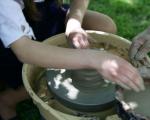Kuksha - Perisoreus infaustus: description and images of the bird, its nest, eggs and voice recordings. External signs of Kuksha
Kuksha- a bird slightly smaller in size than a jackdaw, jay or walnut. The top of her body is olive-brown in color, her cap is blackish-brown; the underside is greyish-brown. The tail is red. The Kuksha is exclusively a forest bird; It does not go beyond the forest zone even during non-breeding times. Most often found in the depths of the forest, very rarely found on the outskirts; usually stays below the middle layer of the forest. Flies easily and silently; during flight, the tail opens like a fan. The kuksha's cry is quite loud and is conveyed: "kuk... kuk..." or "kay.. kay..." In addition to the usual cry, you can also hear a variety of "chatter." A very lively and very active bird; less cautious than the jay. There is little fear of man.
Area. Kuksha is widespread in the taiga zone and goes from northern Scandinavia, the Kola Peninsula, the northern half of the European part of the USSR through Siberia to Anadyr, the Okhotsk coast, and Sakhalin. There is no kuksha in Kamchatka. To the north approximately to the border of the forest zone; to the south it goes to the latitude of Moscow, the Southern Urals, Altai, Transbaikalia, adjacent parts of northern Mongolia, and the Ussuri region.
The boreal parts of North America and the mountain forests of Sichuan are characterized by two other species.
Nature of stay. Sedentary and in winter time a nomadic bird, but the size of these migrations is small. As an occasional migrant in winter, the jayfish was caught in Denmark, the Tatras, and Hungary (Menzbier, 1895). In autumn and winter, vagrant jocks are found in the Chkalov area (Zarudny, 1888). Also as winter bird is given for the northeastern part of Kazakhstan (Dolgushin, 1948).
Biotope. Kuksha is a characteristic forest bird. Settles mainly among spruce-fir and cedar-larch taiga. During migrations it is also found in birch forests. Usually settles in remote areas of forests.
Number. It is not the same everywhere, in some places it is found as a more or less common bird, in others it is rare.
Reproduction. Pairs are probably permanent, since the male and female stay together throughout the year, and they apparently do not lose their bonds even when they flock together for a short period of time. Nest in trees of different heights - from 2 to 6 m, on spruce, pine, fir. It is located between the trunk and the branch extending from it, also directly on the branches themselves. The structure is dense, made of dry twigs, insulated with lichens, feathers, stems of herbaceous plants, etc. The nest is 23 cm in diameter, 5-7 cm thick, tray diameter is 9 cm.
The cuckoo nests early. There is one clutch per year. In southern and central Finland sometimes in March, in Lapland in April. The number of eggs is 3-4, occasionally 5. Dimensions are about 28-32.8x21-23.2 mm. The color is greenish or dirty grayish-white with more or less numerous gray and violet-gray streaks, often condensed at the blunt end of the egg. Incubation begins with the first egg. Incubation duration is 16-17 days; 53-61 days pass from the last egg to the chicks’ flight (Parovshchikov).
One of the beautiful taiga birds - the nutcracker. She lives where there is a cedar tree. Krasnoyarsk residents love this bird, but not very much hunters. If the autumn taiga is quiet and there are no nutcrackers, it means that the nut crop has not been harvested this year. If nutcrackers are screaming everywhere and quarreling with each other, it means the cedars are with nuts. But make sure to quickly fill the bags with nuts, otherwise they will rip off the nutcracker cones and leave you with nothing.
Nutcrackers skillfully pull nuts out of cones, easily destroy them with their rather powerful beak. And they don’t so much eat as they hide. This is why a nut harvest, especially one that is not very abundant, can disappear in a matter of days. The nutcracker stuffs its sublingual pouch with nuts and carries them to bury them somewhere in the moss, in the forest floor, in a hummock in a neighboring swamp, in a crack in the bark of a cedar or fir. During the fall, one bird can make a thousand caches, with an average of ten nuts in each, and in total it hides up to 60 - 90 kilograms of first-class nuts per season. She immediately rejects the bad nut and does not take it to her burial place. Not only the housewife can use the pantries; her friends can also unmistakably find the nut by smell, especially in severe frosts. At the same time, all birds consider the reserves to be their own.
In addition, the owner may die for some reason, but the burial remains will remain. And other birds will get them. Nutcrackers often dig in the snow in winter, looking for nuts. They find them by smell. The small nutcracker bird can dig up snow up to sixty centimeters deep.
Also check out this interesting material:
Nutwood storehouses are potential crops for future cedar forests. When there is a large harvest, nutcrackers store more nuts than they need, and some of the storehouses remain untouched. And if the nuts are not chewed by voles, chipmunks, squirrels, sables, shoots will appear in the place of the pantry. Then a brood of young cedars will rise here, but only one of this bunch will survive to fruitful maturity. And if from what the nutcracker has stored for a year, only two cedars grow, and for that the bird needs to be thanked. After all there are hundreds of nutcrackers in the forest, every year two per bird is a lot. All natural cedar plantations in the forest are the work of nutcrackers.
Kedrovka expands the boundaries of cedar forests. This is an amazing symbiosis of cedar and nutcracker, which are very closely related to each other. Chipmunks and squirrels can also carry nuts through the forest. But mice usually eat not only their own supplies, but also sneak up on strangers.
Kuksha
The nutcracker belongs to the corvid family, to which another belongs taiga bird - kuksha, or ronja. In the winter taiga this is one of the most noticeable birds, trusting and curious. The taiga huts always have several kukshas - they pick up food. Some hunters feed the kuksha, and the birds can become tame. Others, on the contrary, shoot them in any case for pecked prey or stolen bait in traps. By the way, a lot of nutcrackers and cuckoos die in traps and traps of hunters.
3.1 Least Concern :
Wikimedia Foundation. 2010.
Synonyms:See what “Kuksha” is in other dictionaries:
And, husband. Art. Russian ed. Report: Kukshich, Kukshichna. Origin: (Kuksha is the name of a bird from the passerine family.) Name day: September 9, October 11. Dictionary of personal names. Kuksha September 9 (August 27) and October 11 (September 28) - Hieromartyr Kuksha of Pechersk... Dictionary of personal names
Kuksha- Perisoreus infaustus see also 18.12.4. Genus Kuksha Perisoreus Kuksha Perisoreus infaustus A bird with loose fluffy plumage, slightly smaller than a pigeon, grayish brown with dark wings, a long, red tail with a black longitudinal stripe... Birds of Russia. Directory
F;, bird Corvus intaustus (garrulus), jay, ronja, wood funnel; ours, with a blue mirror, soybean and ronzha: Siberian, with red-yellow, kuksha (Gmelin mistakenly has kunsha). | * A poorly, unkempt, clumsily dressed woman. | north husk, shell, ... ... Dictionary Dahl
Bird of the raven family. Length 26-30 cm. In coniferous forests of the North. Eurasia... Big Encyclopedic Dictionary
- (died in the 2nd half of the 12th century) a monk of the Kiev Pechersk Monastery, who preached Christianity to the Vyatichi living on the Oka River and was killed by them. His memory is August 27. The story about him in the Epistle of Simon of Vladimir according to Polycarp... Biographical Dictionary
Noun, number of synonyms: 3 bird (723) ronja (4) jay (5) ASIS Dictionary of Synonyms. V.N. Trishin... Dictionary of synonyms
The holy martyr, hieromonk of the Kiev Pechersk Monastery, was killed on August 27, 1217. Biographical information about him is very scarce. It is believed that he was a native of the country of the Vyatichi. He decided to preach Christianity among the pagans of his tribe and among... ... Large biographical encyclopedia
Bird of the raven family. Length 26-30 cm. In the coniferous forests of Northern Eurasia. * * * Kuksha Kuksha (Cractes infaustus), a bird of the raven family. Length 26 30 cm; body weight 70-100 g. The upper body is olive-brown, the cap on the head and wings are blackish... ... Encyclopedic Dictionary
- (Perisoreus infaustus) a bird of the raven family of the passerine order. Body length 26-30 cm, weighs about 80 g. The plumage is thick brownish-gray, the top of the head is dark brown, the wings and tail are red. Distributed in coniferous forests in northern Europe and Asia;... ... Great Soviet Encyclopedia
Blind cuckoo. Perm., Prikam. Iron. About a person with complete or partial loss of vision. /i> Kuksha bird jay. MFS, 52; SGPO, 267 ... Large dictionary of Russian sayings
Kuksha - Cractes infaustus
Appearance.
Somewhat reminiscent of a jay, but smaller. The general color is grayish-brown, the top of the head and wings are dark brown, the undertail is reddish, the tail is red with a longitudinal dark stripe in the middle.Lifestyle.
Inhabitant of the coniferous taiga. During nesting time, a silent, secretive bird. The rest of the time it is quite noisy and noticeable. It lives in pairs and flocks on trees and on the ground. It flies heavily and quietly, with its tail spread out during flight. Common sedentary and nomadic bird.
The nest is made in a tree. Clutch of 3-5 greenish-gray with dark motley eggs in March - April. The cry is a loud “kzhee-kzhee” and a pleasant low whistle “kuk-kuk”. The song is a collection of whistles and dull sounds. It differs from the jay in having a red tail and the absence of white spots in the plumage.
Reference books by geographer and traveler V.E. Flint, R.L. Boehme, Yu.V. Kostin, A.A. Kuznetsov. Birds of the USSR. Publishing house "Mysl" Moscow, edited by prof. G.P. Dementieva. Photo, Image: “Siberian Jay Kittila 20100312” by Estormiz - own work. Under Public Domain License from Wikimedia Commons - https://commons.wikimedia.org/wiki/ File:Siberian_Jay_Kittila_20100312.jpg #/media/File:Siberian_Jay_Kittila_20100312.jpg
Kuksha belongs to the corvid family, the order Passeriformes. This species forms many subspecies inhabiting Far East and Siberia.
External signs of Kuksha
Kuksha is a small bird with loose and soft plumage. The body length of males is 25.5-31.0, females - 24.5-28.4 cm. Males weigh 81-97 g, females - 73-89 g.
The crown and back of the head are blackish-brown in color, sometimes with an admixture of grayish tints. The feathers near the ears and cheeks are brownish. The back is brownish-olive with a grayish or reddish tint. The rump is red with a slight brownish coating. The tail feathers are reddish-gray and only the middle is gray-brown. The flight feathers are brown, with a bright red hue at the base. The covert feathers on the wings are also red, but with brown tips.
The throat of the kuksha is light gray. The underparts are olive-brown. The beak is black, short, slightly curved at the end. The nostrils are covered with bristles 1/3 of the length of the beak. Legs are black. The tail is long, slightly rounded. Young cuckoos have a lighter top of the head, a darker back, and short feathers on the head and back of the head.
Distribution of the Kuksha
The habitat of the kuksha is in the taiga zone, the border of the species' distribution runs from the north of the Scandinavian and Kola Peninsulas, the north of the European part of Russia through Siberia to Anadyr and further to the Okhotsk coast and Sakhalin Island. Absent in Kamchatka.

In the north, the jayfish lives close to the forest border; in the south it is distributed to Moscow, the Southern Urals, Transbaikalia, northern Mongolia, and the Ussuri taiga.
Kuksha habitats
Kuksha lives only in forests.
Selects remote taiga areas with forests of spruce, fir, cedar, and larch. In winter, it inhabits northern birch forests, wandering around small settlements.

Kuksha breeding
During the breeding season, the male juk sings a chirping song to notify of the occupied territory. A not very musical solo attracts the attention of the female and signals to the already chosen friend that she is ready to breed. Pairs may form for a long period, because the birds stay together throughout the year and fly away in the same flock.

Kuksha hatch chicks in early spring in March - April.
The bird's nest is built on spruce, fir, and cedar pines at a distance of 2 to 6 meters from the soil surface. It is usually located between the trunk and a branch extending horizontally from it, or on branches in the crown of the tree. The construction is dense. Construction material are dry twigs, grass stems, pieces of lichen. A thick layer of hair with white partridge feathers is laid out in the tray. The diameter of the nest is about 23 cm, the thickness is 5-7 cm. The tray measures 9 cm.

Birds have only one clutch per year. The female lays 3-4 eggs, rarely 5. They measure about 2.8-3.3×2.1-2.3 cm. The shell is colored greenish-gray or off-white. Numerous violet-gray or dark gray specks are noticeable on it. They form dense clusters at the wide end of the egg.
Incubation lasts 16-17 days. The chicks are born when all the snow cover has melted. Offspring long time does not leave the nest for about 5 weeks, which is an incredibly long time for passerine birds. They leave the secluded place already in July. From the last egg until the chicks fled, a period of 53-61 days passes.

After the chicks hatch, the jigsaws become silent and timid. At the end of summer, birds wander through the taiga in search of food.
Kuksha feeding
Kukshi mainly hunt insects.
Kuksha forage for food on spruce, fir, and cedar trees. Sometimes they eat the eggs and chicks of other birds, and even hunt shrews and voles. In autumn they switch to feeding on berries. In winter, conifer cones are split open to extract the seeds. Kukshas rob other people's nests. Perhaps they store lingonberries in hollows for the winter.

Kuksha migrations
The Kuksha is a sedentary bird, and in winter it is a nomadic bird, but the length of these movements is small. In winter, jaybirds migrate from north to south to deciduous forests. But most birds prefer the dark coniferous taiga. They feed near rivers, where there are many rowan berries, or peel cones in cedar forests.

Wintering migrant birds have been found in Denmark, the Tatras, Hungary, and northeast Kazakhstan.
Peculiarities of behavior and number of juksha
The number of cuckoos is not the same everywhere. In some places it is a common species, in others it is a rare bird.
Unlike the nutcracker and jay, the kuksha is a calm bird and lives in the forest completely unnoticed, especially during the nesting period. It flies silently and easily, with its tail spread wide. Kuksha is always on the move, constantly in a hurry and does not sit in one place. The calls of cuckoos are quite loud, but hearing them is a relatively rare event.

Bird pairs or small flocks flutter through the trees and communicate with melodious calls. According to one of the bird lovers: “When the cuckoos chat in this way, it seems as if you are hearing a conversation between several people explaining themselves in an unknown language.”
The kuksha lives in the real wilderness of the forest, and does not thrive in open glades and even the edges of the forest.
In summer, the bird always hides in the thicket of the forest, flying from tree to tree. Sometimes, like a tit, the cuckoo attaches itself to the trunk, and then jumps along the branches, then moves along them from bottom to top. Hunters in snares set for game often find caught hazel grouse pecked by jocks. Because of this local residents they do not like the bird because it spoils their prey.

The Kuksha is not a very cautious bird and can let a person get close to it. Curiosity always takes over, and she herself flies up to the hunters and sits down only 2-3 meters from the person.




